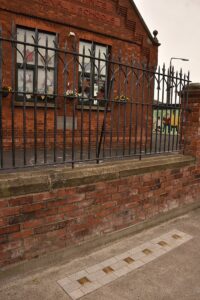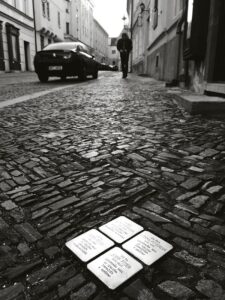Stolpersteine Portugal

“Stolpersteine” is a German word that translates to “stumbling stones.” It is a project created by Berlin artist Gunter Demnig. These are cubic concrete stones measuring ten by ten centimeters with one side covered by a brass plate. The plate contains an inscription about the survivor, victim, or location.
The “stumbling blocks” are placed on the sidewalk in front of the victim’s former home or on the street if the home no longer exists. They can also be found at historic sites related to World War II.
The aim of the project is to create small monuments in memory of the victims of Nazism. These include those who survived, perished during deportations, perished in concentration camps, or chose suicide to escape extermination. The stones are also placed in historic locations such as ports, squares, ghettos, and others.
Why bring it to Portugal?
The Stolpersteine project is present in almost all European countries, with the exception of Portugal, Belarus, Bulgaria, Estonia, Bosnia-Herzegovina, Montenegro, Albania, and North Macedonia. In addition to its monumental symbolism, the project integrates information on people and tribute locations into its database. This allows us to tell our story in Europe and show our awareness of tolerance by honoring these individuals and places.


In addition to recognizing victims and raising awareness, the Stolpersteine project is related to many other heritage, preservation, and intercultural dialogue projects.
In Portugal, there are historic sites such as the port of Lisbon, the former Israeli Economic Kitchen, and the house of Aristides de Sousa Mendes in Cabanas de Viriato. There are also several dozen Portuguese victims and survivors from different regions of the country. This adds value to the Stolpersteine project in Portugal as it is not restricted to large cities and has a national impact.
An interesting fact about the Portuguese Stolpersteine project is that the majority of Holocaust victims from Portugal were not Jewish. Bringing the Stolpersteine project to these locations is a way to value local memory and promote education on a subject that is part of these people’s heritage.

A Holocaust survivor once said:
that education and dialogue are the only ways to raise awareness. Memories and stories of those who suffered exist in the memories of their families, in documents, photographs, artistic, academic, and literary productions, or simply through their names.”
“Forgetting and not educating future generations is the only way to erase these memories. We must encourage actions that exalt the memory and history of the righteous. Good actions must be encouraged because remaining silent and harming good actions is colluding with oppressors.”
The ultimate goal of this project is to make our society fairer and never forget the memory of our Portuguese people.
